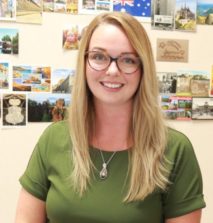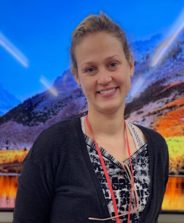
Profiles by Sarah Yu, Caitlin Kaliski, Peyton De Winter and Josette Thornhill

Jerrica Keane
History
Where were you before Aragon, what do you teach and how long have you been teaching?
I’m from Canada, but last year I taught at Capuchino High School. I teach history.
How is Aragon different from places you’ve worked at before?
Aragon’s different because the staff is extremely helpful … especially with being a new teacher, it can be difficult to go to a new school [especially] being from Canada. The opportunities for students are incredible here. There’s so much opportunity that I haven’t seen elsewhere … the clubs for one … students have a diverse choice on what they want to be a part of.
Why did you decide to teach history?
I love [history] … when I was in high school, I decided that I wanted to become a history teacher. I had a really awesome high school history teacher. And he just made me fall in love with Germany … it wasn’t so much German history … it’s more about the culture [than] the history, although obviously I’m a history teacher, so I love it. I knew that I wanted to teach. And then I went into university, and I fell in love with history. So I actually ended up doing way more history school than I needed to. Like, more courses … and then I became a teacher.
What do you like about German history?
This teacher just spoke so vividly about the castles and how beautiful Germany is. Honestly, I can’t really pinpoint what it is about Germany, but I was just like, yep, I’m going to move there, and, I’m gone, learning German. And so I actually did spend time in Germany and I loved it. It was just so cool. Lots of deep, deep history there too. [It was] really interesting, like how deep those connections to communism are. When I was living in Germany, older German people didn’t like me, just strictly because I spoke English.
What are you looking forward to most this year?
I’m excited to learn … because I’m a new teacher, not just at Aragon, but in general. I’m really excited to see how much I learn, because last year when I was at Capuchino, I learned so much that I really didn’t even know it was possible. And that was just year one, so I’m really excited to continue that. Aragon’s just so supportive.

Bonnie Larson
English
What do you teach, and how long have you been teaching?
I teach Special Ed English. This is my fifth year teaching, but my first year at Aragon.
Where were you before Aragon? And how is Aragon different?
I taught at Fremont, [and] Aragon people seem to like each other more here. Teachers here [also] work together a lot more than [teachers at] my old school. They do a lot of planning together, [and] they work together really well … they don’t really argue about who’s right or which way is better. So all around I think [they] are more professional and more organized.
What advice do you have for high school students?
High school is really hard. Being a teen can be super awful. Try to be a nice person, and it’ll get better.
“Being a teen can be super awful. Try to be a nice person, and it’ll get better.”
Where’s the favorite place you’ve been to or traveled to?
My favorite place that I’ve been to is Rome… it is so beautiful. And everything is so old and so cool. And it’s just amazing. It’s very different … you are surrounded by history everywhere you go – people live with it. On the west coast we don’t really interact with history on a daily basis.
What are your hobbies?
Number one hobby is sleeping. It’s my favorite activity. I camp a lot. I travel.
Hanging out with family.
What is your favorite dessert?
Anything peanut butter and chocolate.
Lastly, what are you looking forward to most at Aragon?
I’m really looking forward to getting used to a new school … getting to know new kids and getting into the swing of things at Aragon.
Peyton Pickenpaugh
Ceramics and Digital Photography
Can you tell me about yourself?
I’ve been a teacher for over 15 years, I’ve taught in Japan, Oakland … and San Francisco. I was most recently teaching at Thurgood Marshall in San Francisco. I’m a ceramics artist myself so I do a lot of pottery at home, I love ceramics, I also love photography … this is my first time teaching photography but I’m really enjoying it so far. I’m originally from Mississippi. After college I left Mississippi and moved to Japan for four years and that’s where I met my husband, he’s Canadian. He’s a software engineer and wanted to move to San Francisco, so we got married and came here to San Francisco. We live in the Mission in San Francisco and we have two kids. I have a daughter who’s five and a son who is two and a half.
When did you start doing ceramics?
My father is [a ceramics artist]; I lived in a ceramic studio [and] our house is above the studio and his gallery, so I’ve always done ceramics. I don’t remember a point where I didn’t … My mother was a teacher and she also does ceramics, and then my sister recently started doing ceramics. So the whole family does it.
Why did you choose to teach instead of doing ceramics full time?
I didn’t really get into teaching art until maybe six years ago … [before] I actually got my Master’s in history. I got interested in history because of a really good teacher [I had] in high school. I was always interested in history, so I studied [that]. When I was getting my master’s I realized … you have to [spend a lot of time] in the archives, and it would just be a lot of research if you want to go and get your Ph.D. It just wasn’t enough people contact for me. I decided, ‘I’ll teach,’ [and that’s what I did] when I went to Japan. I combined going abroad with teaching English. That was my first entry to teaching. I wasn’t actually doing art for a long time. Then when I came back, I was teaching and doing pottery in my own time. So then I realized … I [needed] to just start teaching art because that’s what I want to do.
Before you became a history teacher did you consider ceramics as a career?
When I was growing up I was always interested in art. But I think I thought that art was kind of like singing, that you were either given the talent or you weren’t … not that you don’t have to cultivate a voice, you do. I guess I just didn’t have the confidence. I was also just into drama … [and] it’s hard to do everything.
“I thought that art was: ‘You were either given the talent or you weren’t.’ I guess I just didn’t have the confidence”
When you’re not teaching, what are you doing?
I do a lot of my own ceramics [and] a lot of mothering … taking care of my kids, [going] to the park, and we try to get out in nature as much as we can I like to cook a lot and I like to garden … I love to read.
Could you see yourself teaching at Aragon for a long time?
I do, could be like forever … or until I retire. I’m also part-time [and] that works really well for me because I have a lot of responsibilities with my kids, I can [teach] and still have time with them. I hope to build the ceramics program some more … I’m hoping people will become more interested in it and take it.
Elke Calvert
Dance
Can you tell me about your dance career?
I started dancing when I was 4 years old. My mom put me in a dance studio in San Mateo called Kirkpatrick, and I started there. After that, I fell in love with [dancing] and decided I wanted to pursue it seriously when I was about 12 years old. I found a pre-professional dance company in Mountain View called Teen Dance Company, so when I was at Aragon, I actually would go after school. We didn’t have a dance program at the time at Aragon. I would rehearse there from about 4 p.m. to 9 p.m. everyday, so it was quite a commitment, but I loved it a lot. We would perform in festivals and concerts around the Bay Area, [and] we would also attend competitions, but we never did it for the awards. After that, I decided to major in dance at Chapman University, [where] I got my BFA in dance performance. Then, I took two years off to work in the Los Angeles dance industry. So I got an agent, I danced [in] a company there, and performed throughout Orange County and Los Angeles. After that, I decided I wanted to go back and get my master’s degree, so I got my MFA in dance and pedagogy at UC Irvine. That was 2013-2015. Then I moved back. I continue to teach and create my own choreography. I actually started my own project dance company … called Fiber [which] was created based off of my thesis that I worked on during my master’s degree. I kind of brought it to life once I came back to the Bay Area. We performed in different projects throughout San Francisco, [and] we actually opened a new dance studio [and] performance center … that was pretty fun. Since then, I’ve been working as an arts administrator for a dance school and music school. I still continue to teach, and now I’m teaching at Aragon, so I’m very excited
How do you think Aragon has changed and how has it kept its traditions?
I would say Aragon has changed a lot since [I was a student] here. If anything, the culture has grown a lot more, which is really cool to see. I feel the student body and the morale is a lot more involved. There are so many resources the students have access to that we didn’t have when I was here. Traditions wise, I know there’s still the Silver Sword Award and pep rallies and prom and homecoming and all those types of traditions, but I think everything’s just grown to a bigger capacity, so that’s really exciting to see. And the fact that there’s a dance department here is pretty awesome.
“The culture has grown a lot more … the student body and the morale is a lot more involved”
How did your friend Ms. Reidy, the previous dance teacher, contribute to your job opportunity at Aragon?Ms. Reidy and I were friends back at UC Irvine … she was an undergrad … when I was in the master’s program, so I put her in a lot of my choreography and pieces that I had performed. We got to become really good friends through that, and when we moved back to the Bay Area, she actually joined my company, so I had her performing in almost all my projects I had in San Francisco. Since then, we’ve become really good friends.
What is your dance style and teaching method?
I am really passionate about all styles. I definitely focus more on contemporary, modern jazz styles. But, of course, I know there’s a time and place for all of them. I love visual arts and creating pieces that are really visually aesthetically pleasing … [as well as] working with props and things like that. In terms of teaching methods, I have a lot of different methodologies that I’m bringing to the table. I have a language of dance alphabet that I’m using to teach my students different types of movement qualities, so we’ve been starting with that. I’m really passionate about student choreography.
What can your students and the Aragon audience expect from the dance department this year?
I would say they can expect a wide range of different styles on stage as well as everyone in the department getting an opportunity to perform. I’m really passionate that no matter what level you are, you get to experience what it’s like on stage.
Chuan-Hsiu Chueh
Chinese
Can you tell me about yourself?
I was born and grew up in Taiwan, I learned Taiwanese and then Mandarin at home when I was little. I started learning Mandarin in the first grade at school. I have two sisters and one brother [who] are still living in Taiwan. I met my husband who is an American after I graduated from college. After we got married, we moved back to the U.S. I have a daughter who has graduated from college, and a son who is in the 10th grade.
Where did you teach before Aragon?
I started teaching Mandarin after we moved back to Berkeley, and previous to Aragon I taught Mandarin to students from kindergarten to eighth grade for a number of years. I also taught Mandarin at Berkeley High School as a substitute teacher for three years.
What do you like about teaching Chinese?
As a teacher, Mandarin requires patience and care. I would like to see students who have competence in learning a new language and can make progress in the subject.
“Mandarin requires patience and care. I would like to see students [that] can make progress in the subject”
What’s your favorite place that you have traveled to?I say Japan. Japan has [a] very clean environment, and I think people there are nice and friendly. Although sometimes maybe it’s kind of hard to communicate. Because they speak Japanese [and] I can only speak a little bit of Japanese. We try to speak English with them, but they do not quite understand [what we’re saying] sometimes.
What are your hobbies?
I like to watch your Chinese historic dramas, watch movies and singing Chinese songs.
What do you like about Aragon so far? What are you looking forward to here?
I think teachers are friendly here, and would love to help me in any way, I’m a new teacher … I’m still trying to get used to [Aragon] and fit in. Just a lot I need to familiarize with, and try to help students learn.
What’s your favorite dessert?
Anything? I like yogurt [if] that’s considered a dessert. Or pudding.







